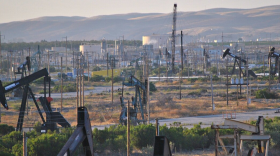-
Santa Barbara County denied Sable Offshore Corporation the right to operate several oil and gas facilities, including a pipeline that caused the 2015 Refugio Oil Spill. But, a new federal filing shows the company may be pursuing another path forward.
-
Over the last few months, the Trump administration has made moves to open up more of California’s coastline to offshore drilling — including here on the Central Coast.
-
Farmworker communities and environmental groups across the state are calling for stronger protections from a pesticide they say endangers public health.
-
The debate over California’s energy future and the role of the Diablo Canyon Nuclear Power Plant continues. State regulators are pressing Pacific Gas & Electric (PG&E), the plant’s operator, to make stronger environmental commitments.
-
After hours of heated debate, the future of offshore oil production off the Santa Barbara coast continues to be uncertain. County Supervisors rejected a proposal that would allow an oil company to operate an offshore oil field connected to the 2015 Refugio Oil Spill.
-
A California judge has sided with state regulators in the fight over restarting the oil pipeline that ruptured at Refugio Beach in 2015.
-
After one mega fire and other wildfires in California, the City of Arroyo Grande is taking measures to address wildfire risk by addressing dry vegetation.Fire Prevention Week is underway.Under a collaborative plan,the San Luis Obispo Fire Safe Council, the City of Arroyo Grande and the Five Cities Fire Authority will soon begin reducing the potential for wildfires in Arroyo Grande.
-
The newly updated State Wildlife Action Plan 2025 was released this week by the California Department of Fish and Wildlife. The plan highlights how California should protect wildlife throughout the state.The State Wildlife Action Plan is updated every 10 years and focuses on protecting habitats and species, like snakes, bats, fish and frogs, that are not legally listed as endangered, but are at risk, as well as those that are on the endangered list.
-
Chevron is preparing to hand over thousands of acres of land on California’s Central Coast—land that was once a sprawling oil field. It's now on track to become a protected wildlife habitat.
-
The Gifford Fire surged in size between Sunday and Monday. As of Monday night, the fire was mapped at more than 72,000 acres with 3% containment, according to the Los Padres National Forest incident web site.
-
Federal officials are celebrating the restart of an oil platform off California’s Central Coast. But, local advocates are pushing back saying that hasn’t quite happened yet.
-
Representatives from Mothers for Peace on Friday requested a public hearing before the California Coastal Commission and an analysis of all environmental risks stemming from the Diablo Canyon nuclear power facility.
















